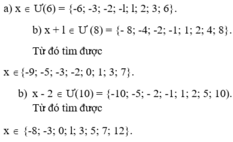
Hãy nhập câu hỏi của bạn vào đây, nếu là tài khoản VIP, bạn sẽ được ưu tiên trả lời.


a: =>2x^3=58-4=54
=>x^3=27
=>x=3
b; =>(5-x)^5=2^5
=>5-x=2
=>x=3
c: =>(5x-6)^3=4^3
=>5x-6=4
=>5x=10
=>x=2
d: (3x)^3=(2x+1)^3
=>3x=2x+1
=>x=1
1=>2x3=54
=>x3=27 =>x=3
2=>(5-x)5=25
=>5-x=2
=>x=3
3=>(5x-6)3=43
=>5x-6=4
=>5x=10=>x=2
4=>3x=2x+1
=>x=1

\(2x-10,01=19,01-3\\ \Rightarrow2x-10,01=16,01\\ \Rightarrow2x=16,01+10,01\\ \Leftrightarrow2x=26,02\\ \Leftrightarrow x=26,02:2=13,01\)
2x-10,01=19,01-3
=> 2x-10,01= 16,01
=> 2x= 16,01+10,01
=>2x= 26,02
=> x= 26,02: 2= 13,01

a; \(x\) + 6 ⋮ \(x\) + 1 (\(x\) ≠ - 1)
\(x\) + 1 + 5 ⋮ \(x\) + 1
\(x\) + 1 \(\in\) Ư(5) = {-5; -1; 1; 5}
\(x\) \(\in\) {-6; -2; 0; 4}
\(x\) + 6 ⋮ \(x\) + (-1) (\(x\) ≠ 1)
\(x\) + - 1 + 7 ⋮ \(x\) - 1
7 ⋮ \(x\) - 1
\(x\) - 1 \(\in\) Ư(7) = {-7; -1; 1; 7}
\(x\) \(\in\) {-6; 0; 2; 8}
b; \(x\) + 6 ⋮ \(x\) - 2 (đk \(x\) ≠ 2)
\(x\) - 2 + 8 ⋮ \(x\) - 2
8 ⋮ \(x\) - 2
\(x\) - 2 \(\in\) Ư(8) = {-8; -4; -2; -1; 1; 2; 4; 8}
\(x\) \(\in\) {-6; -2; 0; 1; 3; 4; 10}
\(x\) + 6 ⋮ \(x\) + (-2)
\(x\) + 6 ⋮ \(x\) - 2
giống với ý trên

`**x in NN`
`a)x+12 vdots x-4`
`=>x-4+16 vdots x-4`
`=>16 vdots x-4`
`=>x-4 in Ư(16)={+-1,+-2,+-4,+-16}`
`=>x in {3,5,6,2,20}` do `x in NN`
`b)2x+5 vdots x-1`
`=>2x-2+7 vdots x-1`
`=>7 vdots x-1`
`=>x-1 in Ư(7)={+-1,+-7}`
`=>x in {0,2,8}` do `x in NN`
`c)2x+6 vdots 2x-1`
`=>2x-1+7 vdots 2x-1`
`=>7 vdots 2x-1`
`=>2x-1 in Ư(7)={+-1,+-7}`
`=>2x in {0,2,8,-6}`
`=>x in {0,1,4}` do `x in NN`
`d)3x+7 vdots 2x-2`
`=>6x+14 vdots 2x-2`
`=>3(2x-2)+20 vdots 2x-2`
`=>2x-2 in Ư(20)={+-1,+-2,+-4,+-5,+-10,+-20}`
Vì `2x-2` là số chẵn
`=>2x-2 in {+-2,+-4,+-10,+-20}`
`=>x-1 in {+-1,+-2,+-5,+-10}`
`=>x in {0,2,3,6,11}` do `x in NN`
Thử lại ta thấy `x=0,x=2,x=6` loại
`e)5x+12 vdots x-3`
`=>5x-15+17 vdots x-3`
`=>x-3 in Ư(17)={+-1,+-17}`
`=>x in {2,4,20}` do `x in NN`
a) Ta có: \(x+12⋮x-4\)
\(\Leftrightarrow16⋮x-4\)
\(\Leftrightarrow x-4\inƯ\left(16\right)\)
\(\Leftrightarrow x-4\in\left\{1;-1;2;-2;4;-4;8;-8;16;-16\right\}\)
hay \(x\in\left\{5;3;6;2;8;0;12;-4;20;-12\right\}\)
Vậy: \(x\in\left\{0;5;3;6;2;8;20\right\}\)
b) Ta có: \(2x+5⋮x-1\)
\(\Leftrightarrow7⋮x-1\)
\(\Leftrightarrow x-1\in\left\{1;-1;7;-7\right\}\)
hay \(x\in\left\{2;0;8;-6\right\}\)
Vậy: \(x\in\left\{0;2;8\right\}\)
c) Ta có: \(2x+6⋮2x-1\)
\(\Leftrightarrow7⋮2x-1\)
\(\Leftrightarrow2x-1\inƯ\left(7\right)\)
\(\Leftrightarrow2x-1\in\left\{1;-1;7;-7\right\}\)
\(\Leftrightarrow2x\in\left\{2;0;8;-6\right\}\)
hay \(x\in\left\{1;0;4;-3\right\}\)
Vậy: \(x\in\left\{0;1;4\right\}\)
d) Ta có: \(3x+7⋮2x-2\)
\(\Leftrightarrow6x+14⋮2x-2\)
\(\Leftrightarrow20⋮2x-2\)
\(\Leftrightarrow2x-2\in\left\{1;-1;2;-2;4;-4;5;-5;10;-10;20;-20\right\}\)
\(\Leftrightarrow2x\in\left\{3;1;4;0;6;-2;7;-3;12;-8;22;-18\right\}\)
\(\Leftrightarrow x\in\left\{\dfrac{3}{2};\dfrac{1}{2};2;0;3;-1;\dfrac{7}{2};-\dfrac{3}{2};6;-4;11;-9\right\}\)
Vậy: \(x\in\left\{2;0;3;6;11\right\}\)
e) Ta có: \(5x+12⋮x-3\)
\(\Leftrightarrow27⋮x-3\)
\(\Leftrightarrow x-3\in\left\{1;-1;3;-3;9;-9;27;-27\right\}\)
\(\Leftrightarrow x\in\left\{4;2;6;0;12;-6;30;-24\right\}\)
Vậy: \(x\in\left\{4;2;6;0;12;30\right\}\)

5.
$4x+3\vdots x-2$
$\Rightarrow 4(x-2)+11\vdots x-2$
$\Rightarrow 11\vdots x-2$
$\Rightarrow x-2\in \left\{1; -1; 11; -11\right\}$
$\Rightarrow x\in \left\{3; 1; 13; -9\right\}$
6.
$3x+9\vdots x+2$
$\Rightarrow 3(x+2)+3\vdots x+2$
$\Rightarrow 3\vdots x+2$
$\Rightarrow x+2\in \left\{1; -1; 3; -3\right\}$
$\Rightarrow x\in \left\{-1; -3; 1; -5\right\}$
7.
$3x+16\vdots x+1$
$\Rightarrow 3(x+1)+13\vdots x+1$
$\Rightarrow 13\vdots x+1$
$\Rightarrow x+1\in \left\{1; -1; 13; -13\right\}$
$\Rightarrow x\in\left\{0; -2; 12; -14\right\}$
8.
$4x+69\vdots x+5$
$\Rightarrow 4(x+5)+49\vdots x+5$
$\Rightarrow 49\vdots x+5$
$\Rightarrow x+5\in\left\{1; -1; 7; -7; 49; -49\right\}$
$\Rightarrow x\in \left\{-4; -6; 2; -12; 44; -54\right\}$
** Bổ sung điều kiện $x$ là số nguyên.
1. $x+9\vdots x+7$
$\Rightarrow (x+7)+2\vdots x+7$
$\Rightarrow 2\vdots x+7$
$\Rightarrow x+7\in \left\{1; -1; 2; -2\right\}$
$\Rightarrow x\in \left\{-6; -8; -5; -9\right\}$
2. Làm tương tự câu 1
$\Rightarrow 9\vdots x+1$
3. Làm tương tự câu 1
$\Rightarrow 17\vdots x+2$
4. Làm tương tự câu 1
$\Rightarrow 18\vdots x+2$

a) x Î Ư(6) = {-6; -3; -2; -l; l; 2; 3; 6}.
b) x + l Î Ư (8) = {- 8; -4; -2; -1; 1; 2; 4; 8}. Từ đó tìm được
x Î{-9; -5; -3; -2; 0; 1; 3; 7}.
c) x - 2 Î Ư(10) = {-10; -5; - 2; -1; 1; 2; 5; 10). Từ đó tìm được
x Î {-8; -3; 0; l; 3; 5; 7; 12}.

a) 4 chia hết cho x
=> x \(\in\) Ư(4) = {1;-1;2;-2;4;-4}
Vậy x \(\in\) {1;-1;2;-2;4;-4}
b) 6 chia hết x+1
=> x+1 \(\in\) Ư(6) = {-1;1;2;-2;3;-3;6;-6}
Vậy x \(\in\) {-2;0;1;-3;2;-4;5;-7}
c) 12 chia hết cho x và 16 chia hết cho x
=> x \(\in\) ƯC(12;16) = {1;2;4}
Vậy x \(\in\) {1;2;4}
d) x chia hết cho 6 và x chia hết cho 4
=> x \(\in\) BC(6;4) = {0;12;24;48;...}
Mà 12<x<40 => x = 24
e) x+5 chia hết cho x+1
=> x+1+4 chia hết cho x+1
=> 4 chia hết cho x+1
=> x+1 \(\in\) Ư(4) = {1;-1;2;-2;4;-4}
Vậy x \(\in\) {0;-2;1;-3;3;-5}
b) \(6⋮x+1\)
\(\Rightarrow x+1\inƯ\left(6\right)\)
hay \(x+1\in\left\{1,2,3,6\right\}\)
Vậy \(x\in\left\{0,1,2,5\right\}\)

bai 2:số số hạng là:(n-2):2+1=n/2
tổng là:(n+2)n/2=220 suy ra (n+2)n=440
mà 440=20.22
suy ra n=20
x+10 chia hết cho 5
=>x={0;5;10;15;...}
=>x là B(5)
x-18 chia hết cho 6
B(6)={0;6;12;...;510;516;522;528;...;696;...}
=>x={510;516;522;528;...696;...}
21+x chia hết cho 7
=>x={0;7;14;...}
=>x là B(7)
